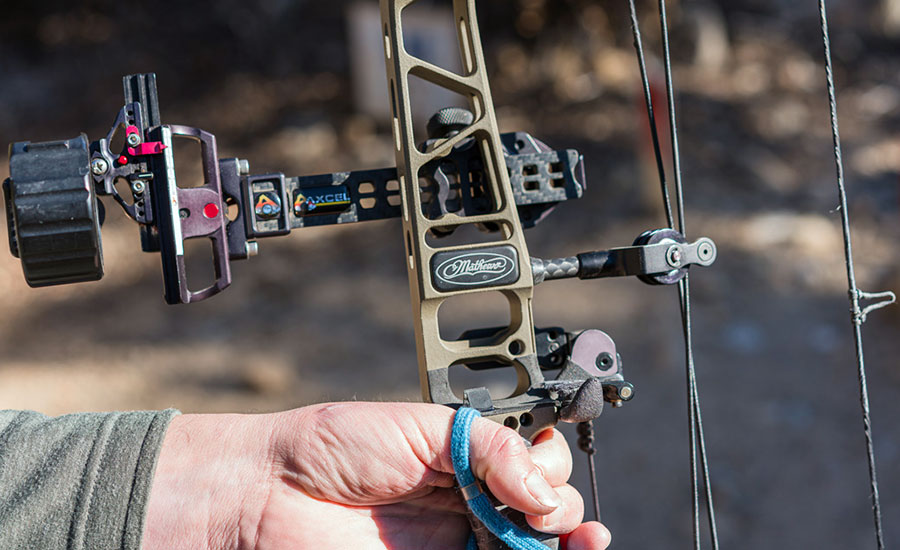Are you upgrading to a new bow? Or just starting out? Or just needed to fine-tune your hunting bow with once-over prior the season?
Then, this content is designed to offer your bow shooting bull eyes. Here is a simple formula that will help you in setting up your bow sights accurately.
Contents
1. Attach the Nock Point
First and foremost, the first thing that will come to your mind is whether to apply a string loop or brass nock set. You need to know the difference between the two, the string loops lengthen the durability of the bowstrings, put in place the release aid directly align with the arrow and equalize the upper pressure to the lower of the nock. By so doing; the arrow remains straight when the bow is drawn and aimed.
Not minding which of the system you concluded to apply, you will need a T-square to locate the point on the string that is parallel to the cushion-plunger hole of the riser.
After this, attach the nock set or the top knot 1/8 of the string loop to ¼ inch above the point parallel to the cushion-plunger hole. If your bow is giving perfect level nock travel, this placement is ideal enough but will need to be readjusted later.
Then, you will know whether it needs to be moved when you paper-tune the bow in step 7.
2. Attach the Rest
You have to make up your mind if you will use a drop-away rest or a fixed position rest. For instance, if you are planning to shoot carbon shafts, a drop-away is highly recommended.
The large-diameter aluminum shaft lets you use either style of rest. Move the rest for the arrow will directly over the middle of the cushion-plunger hole. After that, move the rest so that it aligns with the string.
The best method you can use to get this position is to install a stabilizer, nock an arrow and look down on the bow to find out if the shaft is parallel to the stabilizer.
Also, you might have to tweak the remaining one way or the other later. But sincerely, this is the perfect starting point for you.
If you are using a drop-away rest, you will still require adjustment I the timing of the rise and fall rest.
Actually, the rest will attain its complete upright position when the string is about 6 inches short of a full draw. By so doing; the rest will remain up a little longer when the arrow travels forward. This will provide some guidance prior to falling out of the fletching way.
3. Install the Peep Sight
It is not good to shoot a rifle without a rear sight and the same is applicable to a compound bow. Do not shoot a compound bow without a peep sight. A bow press is required before you can install most peep sights.
In case you do not have it, then check out in any pro shop, buying a portable bow press one will go a long way. What matters most when you want to install peep sight, the principal thing is to locate the middle of the string.
For those with the string of bow with two different colored strands well twisted together, it is advisable to join them separately otherwise, you will need to count the strands and divide into two.
This step is very crucial because if the peep sight is not in the center of the string, it can easily spin extremely when drawing back the bow.
When you might have placed the peep sight in, the next thing is to install string silencers. But if you are using brass nock sets, you will need to install eliminator buttons.
These are the buttons with little rubber donuts that side onto the string so as to cushion the nock of the arrow from the release of the jaws aid. After that, take the bow out of the press, place an arrow on the string and draw it back.
Look through the peep sight to find out whether it requires advance adjustment. The peep sight must align perfectly with your eye and the middle of the sight window anytime you are at your anchor point.

It is very usual to slide the peep sight up and down without placing the bow back in the press but this is not always.
As soon as you have the peep sight at the right height, adhere to its directions so as to secure it in place. The next thing is to shoot the bow many times for you to set the string before bothering about how the peep sight is revolving in the string.
If the peep sight is not rotating to your desired level, what you need to do is to detach an end of the string from the bow and twist the string.
Let the process continue until the peep sight comes back to square your eye at all times. It is very important that the process continues for more than a week of shooting. This will enable the string to attain its fully stretched length.
4. Attach the Sight
Select a strongly constructed bow sight that has fiber optic pins which are very easier to adjust. Prior to your purchase of sight, consider the number of pins you will require.
It is recommended that you go for a few so as to limit confusion. Many whitetail hunters are doing well with two or three pins set for 20 and 30 yards, 25 and 35 yards, or 20, 30, and 40 yards.
The western hunters usually have the chances of making loner shots thereby need to set 4 or 5 pins for 20 to 50 yards or 20 to 60 yards. All you need is to adhere strictly to the instructions written on the package about the installation.
5. Silence the Rest
Your bow needs to be quiet when drawing and firing. A thin layer of adhesive-backed foam rubber or fleece on the riser is highly recommended as this will enable your arrow to fall off the rest and not clatter when hits the shelf of the riser.
6. Reserve Your String
After you have shot your bow a few hundred times, you need to carry out two steps of maintenance below:
- In case the string has stretched, just twist it back down to its original length because the stretchy string will force you to make a deeper and more uncomfortable anchor point.
- At this level, replacing the serving on your string is highly recommended. It is ideal to pay so as to have it done for you if you are a first-timer. But when doing this, watch and learn from the professional you hire to d it so that when such occur next time, you will be able to do it yourself. When you are watching and learning, pick a spool of serving the material and a good serving jig.
7. Paper Tuning
Cut a square hole at the bottom of a cardboard box. Then tape a sheet of paper through the opening and put a target more than an arrow length behind the sheet of paper.
At this point, stand almost 6 feet away from the box and shoot via the paper to the target. If the arrow cuts a clean, shaft-sized hole with tiny tears that are of a similar width as the fletching, the bow is tuned. If there is a tear wider than the fletching of the arrow to any side of the hole, then some tuning will be needed.
Most of the modern bows are very easy to tune but some do have string-travel issues caused by cam lean when the bow is drawn and arrow released. If you are completely unable to get your bow tune, take the bow to a pro shop for professional help. It could be that the bow itself is at fault.
8. Sighting In
If you sight in the bow, space the pins very close at the center of the sight body but to make sighting simpler, move the sight body to the left or right until the pins and string align with an arrow put on the rest of the bow. After that, move the whole sight up and down when sighting in the top pin.
Move all other pins independently when sighting them in. but if your arrows are hitting the target over the intended spot, move the pin-up. However, if your arrows are hitting to the left of the spot, move the pin to the left and so on.
Prepare to sight in your bow over the course of several days or even weeks. The shooting form can change a bit from a day to the next day hence, it is very important to average the effect with time so as to get the expected results.

